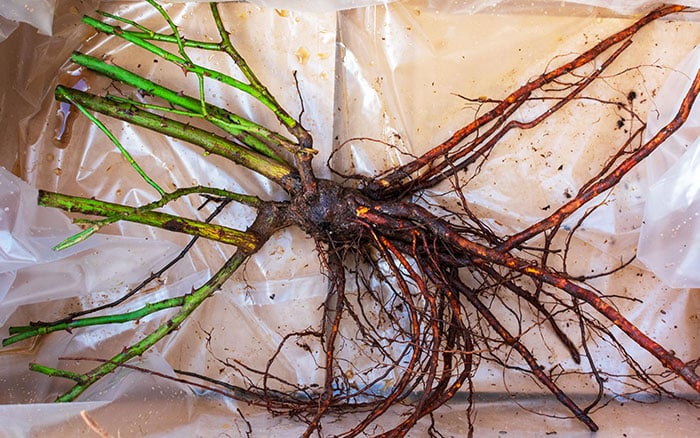Updated 07/02/25
Autumn is a great time to get new shrubs, trees and hedging into the garden. They are naturally dormant at this time of year and the ground is still soft and workable.
Bare-root plants are great because they are cheaper than containerised plants and can get established really quickly. They are plants that have been grown in the ground at nurseries, rather than in pots. You buy them and they are dug up, their roots are wrapped up and they are delivered to your garden ready to go back in the ground.
Bare-root plants are the perfect choice if you have been thinking about planting trees for shade or putting up a new hedge but the high cost has put you off. Here is how to get bare-root plants off to a great start.
Replant them immediately
Plants with bare roots should not be left out of the ground for long. Try and plant them immediately after you receive them. If your site is not quite ready, plant them temporarily in another location.
However, do not plant them if the ground is frozen or waterlogged. If you have to wait a few days, put the rootballs in trays or pots and cover with compost. Keep them in a frost-free place like the shed until the weather is better.
While the roots are bare, be sure to keep them covered with damp rags or hessian. Just before you begin planting, soak the roots in a bucket of water for 20 minutes to rehydrate them.
Prepare the planting site
Start by digging a large hole. It needs to be several inches wider and deeper than the rootball. If you have heavy soil, it is worth planting on a slight mound to improve drainage. But make sure the roots are not exposed. You should also dig a square hole to encourage roots to extend outwards rather than run round in a circle.
If you have very dry soil, fill the hole with water and allow it to drain away. This will make the surrounding soil nice and moist for the roots.
Create a soil mixture to refill the hole with nutrient-rich material. Use half garden soil and half general-purpose compost. You can also add fertiliser but make sure it is well mixed in. It can damage the roots if it comes into direct contact with them. Add some of this mix to the base of the hole.



Get planting
Make sure to spread the roots out as you put the plant in. As with all plants, be careful not to bury it too deep. There should be a soil mark on the stem that shows how deep to plant. Aim to have this line level with the soil surface when you are finished.

If you’re not sure, lay a bamboo cane across the hole at soil level and line up the stem against it. Burying plants too deep will smother them and risk rotting the stem.
Once the roots are spread out, begin filling the hole in layers with your soil mix. This will help ensure the roots are fully covered and there are no air pockets. Firm in each layer before adding more soil mix.
Water the plant in really well and top up with any more soil if the level dips as it settles.
Caring for bare-root plants
Keep watering the plant regularly. Watering heavily means the roots will grow deep into the ground, helping the get the plant established and make it hardier in dry weather. Make sure to water in dry or windy weather too – plants can dry out even when it is cold outside.

Add a layer of mulch around the bare soil. Leaf mould and wood chippings add nutrients to the soil as well as conserving moisture and keeping weeds down. Be careful not to let mulch touch the stems or it could cause rotting. Aim to spread a layer at least 5cm thick across the soil all around the plant.
If you have a problem with rabbits gnawing on young stems, install rabbit guards around singular stems or chicken wire around multi-stemmed plants and rows of hedging. Stake in trees with a strong timber stake and ties.
Order bare-root plants from growers, garden centres and online stockists and plant in autumn or early spring.

I have a question as a first time bare root gardener. I bought some bare root roses that had leaves already growing. I was worried about the frosts and have kept them roots enclosed in the plastic they came in but I pierced some holes in them and every few days give them a soak for a couple of hours. I also have put feed in the water every few soaks. Not knowing if the frosts have passed in the meantime they are very happily growing on my sunny kitchen window sill! But now I’m not sure if the many new fragile leaves will all be wiped out in an unexpected frost! I though buying bare root with leaves was a good sign the root was alive at least but now I think it may be best to plant straight away whilst it has as little leaves as possible. Instinctively ( not always correct!) I was going to wait until the spring to plant them out. Any thoughts?? Thank you for your blog by the way!
Hi Bev. Roses are very hardy and survive frosts. You need to get the plants into the ground as soon as possible or the roots won’t develop properly. Plant them up in pots or in the ground and keep well-watered. Good luck!
Great! Thank you. I didn’t know they could survive frosts. Hope I’m not too late!